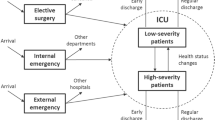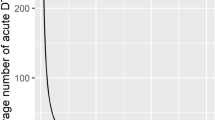Abstract
This paper presents a model for optimizing admissions to an intensive care unit (ICU) where the objective is to maximize the expected incremental number of lives saved from operating the ICU. The probability distribution of the number of occupied ICU beds is modeled using queueing theory. Three different admissions policies are considered: first come first served (FCFS), first come first served for all referrals whose expected incremental survival benefits gained from ICU admission exceed some hurdle (FCFS-H), and first come first served for all referrals whose expected incremental survival benefits exceed a bed specific hurdle (BSH) that depends upon the number of occupied beds (FCFS-BSH). The model is applied to data describing patients referred to the ICU at Jerusalem's Hebrew University – Hadassah Hospital. After statistically estimating the distribution of expected incremental survival benefits among those referred to the ICU, we show that if only those referrals where ICU admission would improve the probability of survival by at least 19.4 percentage points were admitted, an additional 18 statistical lives would be saved annually compared to the FCFS policy, a relative life saving improvement of 17.9%. Implementing the more complex optimal bed specific hurdle policy would save an additional 1.4 statistical lives annually beyond what can be achieved with FCFS-H, a marginal improvement of only 1.2%.
Similar content being viewed by others
References
ESICM, Consensus conference: Predicting outcome in ICU patients, Intensive Care Medicine 20 (1994) 390-397.
Society of Critical Care Medicine Ethics Committee, Consensus statement on the triage of critically ill patients, Journal of the American Medical Association 271 (1994) 1200-1203.
W.A. Knaus, E.A. Draper, D.P. Wagner and J.E. Zimmerman, APACHE II: A severity of disease classification system, Critical Care Medicine 13 (1985) 818-829.
L. Kleinrock, Queueing Systems, Theory, Vol. I (Wiley, New York, 1975).
B.L. Miller and A.G. Buckman, Cost allocation and opportunity costs, Management Science 33 (1987) 626-639.
C.L. Sprung, D. Geber, L.A. Eidelman et al., Evaluation of triage decisions for intensive care admission, Critical Care Medicine 27 (1999) 1073-1079.
A. Shmueli and C. Sprung, Assessing the survival benefits of intensive care, submitted for publication.
Author information
Authors and Affiliations
Rights and permissions
About this article
Cite this article
Shmueli, A., Sprung, C.L. & Kaplan, E.H. Optimizing Admissions to an Intensive Care Unit. Health Care Management Science 6, 131–136 (2003). https://doi.org/10.1023/A:1024457800682
Issue Date:
DOI: https://doi.org/10.1023/A:1024457800682




